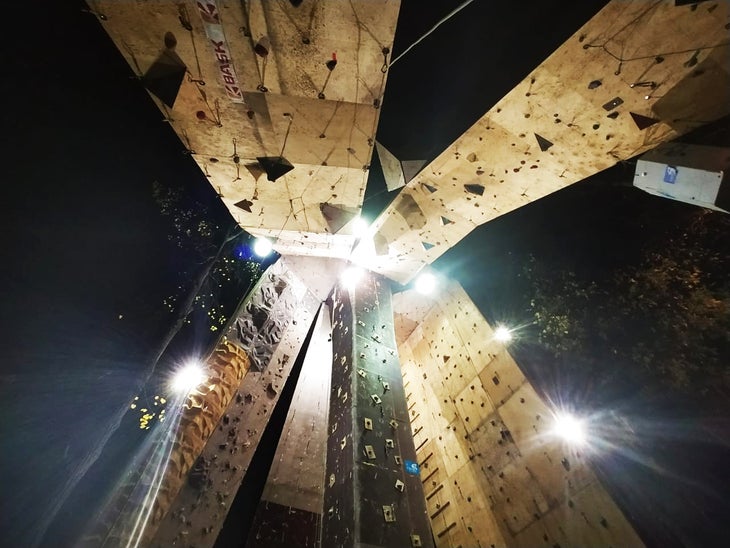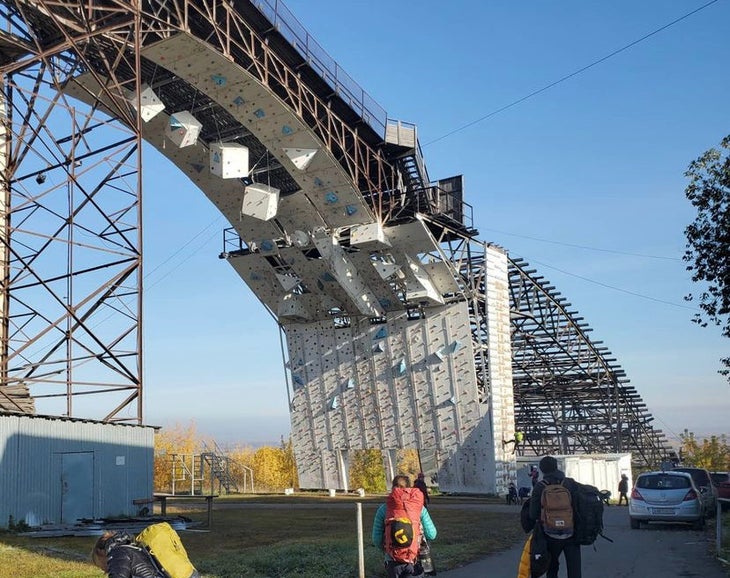The Training Secrets of the Russian Ice Climbing Team
One competition athlete travels to Moscow—and unlocks a training secret she didn’t expect.
Katya had been telling me about Sasha all day. “He is great personal trainer,” she said. “The best. And very pretty.”
I’m not sure what I was expecting. Maybe someone tall and young with a perfect tan and a chiseled jaw. But when we walked into the little Moscow gym—a dim, square room so packed with weight training machines it was hard to walk through—we were greeted with a slightly different version of handsome.
Sasha, short for Alexander, was born in Soviet Russia during the Cold War. He joined the army in his late teens and served for years before deciding to get totally jacked and becoming a weight trainer at this grungy bodybuilders’ gym. Whatever you’re picturing in your head is probably exactly right: Black adidas tank top, massive arms and pecs, wide face, flat nose, buzz cut, chest tattoos, neck tattoos.
He strode up to us. “Devochki,” he said by way of greeting. Girls. He pointed a meaty hand toward the treadmills, demanded a five-minute warmup, and swaggered away to bust out some chest presses. Katya turned to me, batting her eyelashes.
“What did I tell you? Isn’t he pretty?”

That was early October. It was the start of the competition ice climbing season, and my partner Wes and I, who are both on the US Ice Climbing Team, had decided to visit Moscow to train with a few of our friends on the Russian team.
It was just supposed to be a fun trip, but as I packed my bags, I couldn’t help but wonder what secrets we’d unearth. After all, the Russian National Team has achieved—and maintained— total dominance in competition ice climbing for more than a decade. They’re on every podium. By this point, I’ve heard the Russian national anthem more than I’ve heard my own.
During the past year and a half, I’d worked hard to improve my climbing and had even won some competitions. Still, I was nowhere near Russian-caliber. I figured they had to have some kind of futuristic training methods, new exercises, or a different strategic approach. At the very least, they must train more than the US team did. Maybe five hours a day, I imagined. Maybe even six. I eyed the heap of extra shirts in my duffle. Clean clothes weren’t going to help me survive this trip. I took them out and packed a massage gun, an Arm-Aid, three PT bands, and a jug of protein powder instead.
—
Wes and I arrived at Pavel and Katya’s apartment late in the evening. We stayed up until 1:00 a.m. talking and drinking beer.
“Tomorrow morning we do a training,” Pavel said. “We go at seven a.m.” Yipes, I thought. So little sleep. Katya and Pavel were serious athletes—Katya was on the Russian team, and Pavel was one of the best setters the ice climbing world cup circuit had ever seen, not to mention an excellent coach and renowned climber who’s flashed up to M15. I figured the late night and the above-average alcohol consumption were just a one-time anomaly to celebrate our arrival.
—
I was just coming off about four weeks of dedicated strength training. I’d been doing everything that sports science literature—and my more experienced teammates—had told me to do. High weight. Low reps. Ample rest between sets. Weighted pullups, max-weight lat pulls, and weighted core. I was bouldering twice a week and drytooling three times a week. I cut back on alcohol and sugar consumption and prioritized sleep. I was religious about rotator cuff strengthening, warming up, and taking two full rest days per week. After my strength phase, I would focus on power, saving endurance for last. I was doing everything by the book.
So when we woke up early that first morning, I expected a multi-hour session at a climbing gym. Instead, we walked to a local playground and made do with monkey bars, parallel bars, and a set of homemade TRX straps. Every exercise was bodyweight, 15 to 25 reps.
After about 30 minutes, I tried to jump back on the monkey bars for a bonus set of campusing.
“No, no, no,” Pavel said, beckoning me off. “This is enough.” It’s silly to spend hours training, he said. Instead, you should do short, intense sessions so you can get back to resting and recovering as soon as possible. 30 minutes, he said, was plenty. Huh.
That night, we trained on the Moscow Alpine Club’s massive outdoor drytooling structure. Warmup laps were disallowed—Pavel said it was better to save energy for going a muerte on every climb. Resting on the wall was disallowed—Pavel said it was better to get pumped as soon as possible and go hard until you fall. Oh, and no powerful or bouldery moves: the Russians only train endurance this time of the year.
After training, we came home and drank beer and ate cheesecake until 2:00 a.m. I didn’t see a single protein shake. I wasn’t sure what to think.
The next day, Katya invited me to train with her and Sasha. Again, light weight, high reps.
When it became apparent that I could lift more, Sasha seemed concerned. He asked Katya if I was taking steroids. I shook my head, finished my set, and shrugged.
“Easy peasy,” I said.
“Easy peasy?” he repeated. He turned to Katya to tell her that English was a very silly language.
I had lied, of course; I was painfully sore the next morning.

—
Every day, we kept training in all the ways I had been told not: No warmups, no staying hydrated. Three a muerte goes, three sets of pullups—then cake and beer until midnight. For a week in Moscow this was our routine. And when Wes, Katya, and I went north to Kirov to train with several other members of the Russian team, it didn’t differ much.
When I returned home to Colorado, my teammates texted me eagerly. What do the Russians do differently? What did you learn? I was at a loss.
I’d read so many magazine articles about the One Recovery Mistake That’s Holding You Back or the Three Must-Do Exercises To Level-Up Your Climbing Career. I’ve spent hours fretting that I was training the wrong way, that I was leaving out some essential key to success. I had gone expecting to discover a magic recipe, but the only secret I discovered was that there is no secret.
What do the Russians do differently? They’re consistent. They train on their outdoor structures even when it’s raining or snowing. They make a playground do when gyms are too expensive. They have a strong community and a no-excuses mentality. And on every go, they try really f***ing hard.
What did I learn? Even at the elite level, there’s no secret sauce. There’s just showing up every day and giving it all they’ve got.
For me, the takeaway was to stop overthinking things. Pick a training plan and commit to it. Be consistent. Try hard. And don’t be afraid of a little cheesecake.